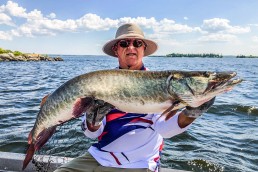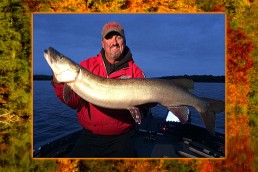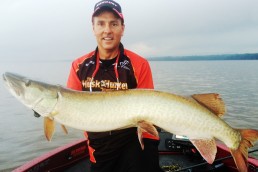Factors That Trigger the Fall Muskie Bite!
SHARE THIS POST
Fishing muskies during the fall can be as rewarding as it is frustrating. If it works out that your outing occurs with favorable weather, muskie activity is bound to be good. However, what some might consider “favorable weather” for muskies in October is actually quite different than in July or August. Stable weather, a preferable condition of summertime, with a warming trend and southerly winds, rarely produces big results in the fall. Instead, cold fronts are usually what trigger big autumn muskie bites.
In fact, the later you fish into the fall period, the more likely it is a cold front will trigger the big bite. This is not news to anyone who has spent a lot of time casting or trolling during the autumn months. However, muskie hunters who are used to summer patterns and a warm weather strategy are often surprised by this fact alone. It is not a warm front that triggers a fall bite. It is killer cold front that really fires things up.
Wind direction alone often dictates the quality of the bite. Generally speaking, southerly winds so vital to a warming trend and a good bite during the summer period rarely excite the fall muskie angler. Instead, northerly winds bringing in a cooling trend or an approaching cold front are preferred. Personally, I get excited in the fall whenever I see a northwest wind in the forecast. Not so much when I see anything out of the south.
On fall trips where muskies are being sighted regularly, the key to your success usually depends upon your ability to trigger strikes—which means a strong emphasis on mastering the figure 8 technique. For those reading this who are new to the sport, trust me when I tell you it is paramount that you perfect this tactic or your catch rate will only be a fraction of what it could be. I can remember many fall trips where well over half of my muskie catches were boatside. This is particularly true when the fish are following spinners or crankbaits. With that in mind, I relish the muskie follow on these lure styles, since so many of these fall fish can be triggered on the figure 8 boatside.
If the bite is noticeably “off,” your focus should shift to a singular purpose—be fully prepared in every way possible for one lone opportunity. Fall fishing is not always full of action. Honestly, it is more often the opposite. This is particularly true on weak weather patterns, such as a day with no wind and bright skies. Warmer fall afternoons might be great for photos and breathtaking scenery, but they usually are poor when it comes to great muskie activity. One single opportunity might be all you get on such outings. Make the most of it. Also, don’t be surprised if this solo strike occurs right after sunset as light begins to wane.
One of my most productive go-to tricks during slow fall bites is to downsize. Bombing big baits have become more the norm today, and they sure do catch lots of big muskies. Today’s rod and reel combos along with superior quality braided line allow one to fish with oversized lures effectively on a regular basis. However, when the bite is off, no matter what the season, downsizing usually turns the tables. I rely far more on lures in the 4- to 6-inch range during lesser conditions and an overall weak bite. The key here is to test your good spots occasionally with smaller offerings when things appear to be slow. At the very least, always throw a downsized version of your most productive lure on any follower. An immediate cast-back with a junior version might be all that is needed to make the muskie commit.
Are you enjoying this post?
You can be among the first to get the latest info on where to go, what to use and how to use it!
Another trick I often employ on tough bite fall muskies is to slow down and concentrate on targets and cover. Remaining stands or patches of weeds, fallen trees on steep banks and submerged man-made fish cribs are three targets that come to mind. In fact, choosing lures that can be worked right next to these targets for extended periods with what I refer to often as “hang time” can yield big results.
A personal favorite lure for this trick is a 5- to 7-inch slab-sided minnow bait. Another good choice is a suspending glider-style jerkbait. I purposely jerk these lures with short rod snaps combined with a lot of slack line when they are near cover accentuating the lateral side-to-side action.
If the lure is a floater, I might also let it rise completely to the surface while it is right next to the target. If it is a suspending glider, I purposely allow the lure to swing dangerously close to a woody snag or thick weed patch before initiating another rod snap. This not only triggers strikes, but also reveals the presence of muskies since they will often rise up out of the cover and depths to at least investigate the bait. By the way, once the lure exits the high percentage kill zone, I will speed things up quite a bit to both trigger a potential strike from any muskie following, as well as pick up time and make the most efficient use of my technique.
Of course, always be prepared to finish any retrieve off with a figure 8.
A weed patch alongside shallow rocks produced this fall beauty for author Joe Bucher.
MWO
SHARE THIS POST
Did you enjoy this post?
You can be among the first to get the latest info on where to go, what to use and how to use it!
Joe Bucher
Joe Bucher is a Freshwater Fishing Hall of Fame Legendary Angler, book author, lure designer and host of Fishing with Joe Bucher TV series.



